Articles
Artists Palette Magazine Demonstration Article Issue 85 Photographs
Photograph of the subject “Thistle Patch – Freemans Reach, NSW, Australia
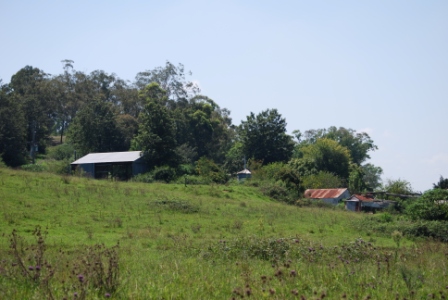

I chose this photo for my subject because I really liked the light,the old sheds and interesting foreground, with the thistles and weeds.
The view is from Hawkesbury, which is known for its atmospheric and beautiful farmland.
I decided to infuse the scene with more light than the photograph and to let the viewer see that you can improve the scene with your own impression. I chose to use a limited palette because this creates a harmonious painting and I use transparent Artist Quality pigments.
I commenced by drawing a simplified version of this scene with a 4b clutch pencil on a half sheet of Arches Torchon Rough 300gsm – because I like the rough texture of the paper surface and feel it’s great for an impressionistic style of painting.
I lay the paper down on the Perspex, and starting with the back of the drawing I soak the paper with plenty of clean water using a large 1 ½” flat wash brush. I then flip the paper over and drawing side up, I soak this as well, for a few minutes, before I squeeze out all the excess water from the paper with a clean dry bath towel, pushing my hands over the towel, making sure that the paper is not wet, but slightly damp and cool to the touch. I paint on a sheet of Perspex (plexi glass) because this allows me to paint on damp paper, which in turn, allows me to paint wet in wet and I can obtain some lovely soft edges and as the paper dries I can then achieve some crisper edges where needed. If the paper starts to dry out around the edges, I just give it a spray of water on the back and the paper will stretch and relax. I might gently pat it down with a towel to flatten the painting again.
I paint with my board at a 30 degree angle to allow the paint to flow down the paper using gravity.
The photos of stages 2 to 5 are darker than the photo of the finished painting because the painting has thoroughly dried and is approximately 10% lighter.
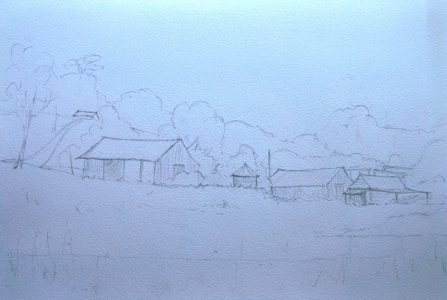

Step 1 ~ Drawing for “Thistle Patch – Freemans Reach NSW, Australia
I begin by drawing the scene onto a half sheet of Arches Torchon Rough 300gsm, from a reference photo and simplifying the details.
I wet the paper with a 1 ½” flat wash brush (back and front).
Placing the paper, drawing side up onto a sheet of Perspex (or sealed marine ply), I use a clean dry towel and press down firmly and evenly to remove excess water and graphite from the surface of the paper.
You can feel the paper with the back of your hand to ascertain how damp the paper is – it should feel cool and slightly damp to the touch.
This method is ideal – if it’s a hot day, no need to pre stretch or tape the paper, it allows you a bit more time for your painting process and also you can achieve soft edges easily.
You must wipe up the paint from around the edges of the paper though, because you might find a back run will occur where you definitely won’t want one! If edges are clean the painting can be float mounted.
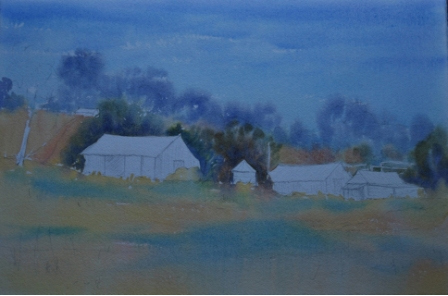

Step 2 ~ The underpainting
Working quickly, I start with an underpainting, wet on damp, starting at the top left hand corner of the paper with a wash of Cerulean Blue, leaving some small whites in the sky for sparkle.
I bring this wash down to the middle ground.
Next, I paint in some Cobalt Blue Deep over the 1st sky wash, to create a deeper layer over the top of the sky, allowing this to blend and merge on the paper.
I return to the middle and foreground and I leave the buildings, pole and trellises as negative space, dropping in a mix of Indian Yellow and Raw Sienna – (added to tone the yellow down a bit) followed by Light Red.
I also add some Cerulean Blue to the yellow mix and allow it to blend on the damp paper, wet in wet, to create a soft green.
While the underpainting is still damp – not shiny wet, I return to the lower part of the sky and create some distant soft edged trees along the horizon with a mixture of Cobalt Blue Deep, Permanent Violet Bluish and a touch of Sepia – to grey it off a little.
Next I mix a selection of greens created from the Indian Yellow, Raw Sienna and Cobalt Blue deep for variety.
I paint in the trees behind the sheds, with these colours, leaving the white of the paper, where the trellises and pole are.
Before this wash dries and the pigment is still slightly damp, I scrape back with my pen knife or fingernail into the foliage some light areas for branches, etc and with a rigger brush I pull through the foliage some dark branches with a dark mix of Sepia and Violet as well. well.
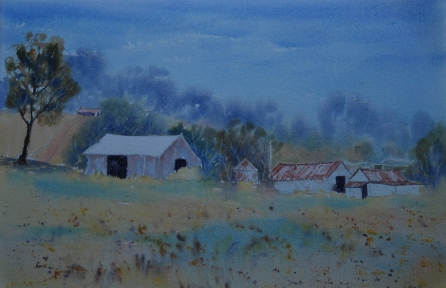

Step 3 ~ Starting to add depth and Texture
I wait for the shine to go off the paper and while it’s still slightly damp, I flick and splatter into the foreground with a variety of the pigments I’ve chosen, some vegemite consistency pigments and a little water.
I protect the painting with some old watercolour paper which I keep for this purpose.
I paint in the left hand tree using a mix of Sepia and Permanent Violet Bluish for a nice strong dark trunk.
I then paint in the foliage using Raw Sienna using the side of my brush, then dropping in a mix of Raw Sienna and Cobalt Blue Deep for a darker foliage area, followed by some bluish purple for shadows. I wait for the shine to go before scraping out some branches in the tree foliage.
I now allow this to dry before continuing on to the buildings.
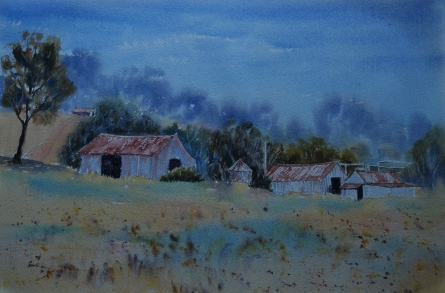

Step 4 ~ Starting on the buildings
The roof and walls of each building are painted wet on dry for a rusty tin effect with Light Red.
I allow this to dry before I paint on a pale bluish purple shadow on the walls of the buildings.
I cut down into the yellows in the foreground, for the grasses and using negative space, create clumps of grasses next to each building.
I allow this to dry and then glaze another wash onto the sides of the buildings that are more in shadow.
I also paint in the darks while the wash is slightly damp with a creamy mix of Sepia, Permanent Violet Bluish and a touch of Cobalt Blue Deep for doorways, windows etc.
I allow this to dry and then glaze a bit more of a shadow under the eaves of each building using the bluish purple mix.
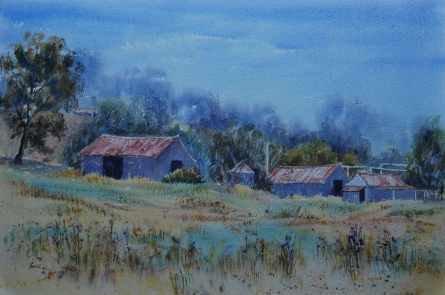

Step 5 ~ Foreground
Next I paint the foreground where I start some of the grasses using positive space.
I use a fan bristle brush for this and I double dip into a creamy consistency of Raw Sienna, Indian Yellow and some of the green mix as well as Light Red.
I dry brush some texture, using the chosen colours, to create interest and to give the appearance of grasses and sticks, etc.
I also add some pure permanent Violet Bluish with the tip of my little finger for Thistle flowers and buds.
I decide to scrub out a small area next to right hand back corner of the large shed with my stiff synthetic bright in order to place a shrub there using Indian yellow for a good contrast of colour.
I drop in some of the bluish purple colour for some shadows while this is still damp.


Step 6 ~ Finishing touches
I decide to make the left hand tree canopy come down a little further to create a better shape, with the same colours as before. I dry the painting thoroughly and decide to scrape out with a scalpel blade, some wire from the pole to one of the buildings.
I put the painting aside. where I can view it for a day or two, before deciding that I am happy with it and finally I add my signature, with a complementary colour.
Lastly I rewet the back of the painting and place it on a board with a clean dry towel on top and then I place another board on top.
I weight the top board with heavy books and leave it to dry perfectly flat for a few days.
Now it’s ready to frame.
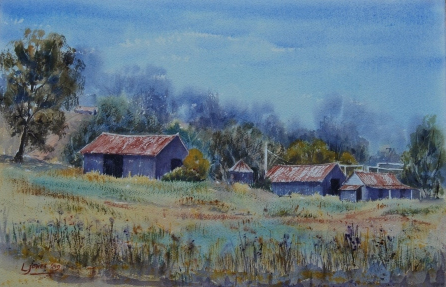

The Finished Painting ~ “Thistle Patch” – Freemans Reach, NSW, Australia
Artists Palette Article ~ Materials List
Artist Quality Winsor and Newton, M Graham and Maimeri Blu tube paints
Arches Watercolour Paper – Torchon Rough 300gsm – half sheet
Colours:
Raw Sienna – M Graham
Indian Yellow, Cerulean Blue, Cobalt Blue Deep, Light Red, Sepia – Winsor and Newton
Permanent Violet Bluish – Maimeri Blu
Brushes: Art Basics 1 ½” flat – for wetting down paper, Large Round Rekab Sable Ester no 12, Roymac round sable no 12, Rekab Sable no 5, Neef Long Handle Rigger no 6, Art basics stiff synthetic bright no 6 – ideal for scrubbing out, Fan Bristle no 6 for texture and positive space grasses.
Clutch Pencil with 4b lead
Clutch pencil sharpener
Kneadable Eraser
Small Swiss Army Knife for scraping back into damp paint
Tissues
Water spray atomiser
Two large jars of clean water
Clean dry bath towel
Washing up sponge or towel for drying your brush after rinsing – between applications
Tips and Hints
- Use Artists quality materials – buy the best you can afford because cheap materials will hinder your progress and frustrate you.
- Practice often, because this will build confidence.
- Plan your painting and simplify by removing unnecessary details.
- Hold your brush well back down the handle, this will help to keep your work from getting tight. Remember you are not painting a wall in your home, so don’t cover all of the paper. Leave some light areas on your paper, for some sparkle, once they are gone they are gone forever.
- Put the paint on and then leave it alone! Fiddling will create muddy colours.
- Learn to observe and absorb. Try en plein air, this is a great way to paint and will improve your paintings, back in the studio.
- Sketch and draw as often as you can, because a good drawing assists in creating a good painting.
- Put out an ample amount of fresh pigments and make sure you mix sufficient paint. There’s nothing worse than not having enough mixed and having to go back and mix more, when your painting is starting to dry. This will cause problems in the wash drying unevenly and could create back runs.
- To keep your paintings from looking muddy, keep the number of washes to a minimum – usually no more than three, because this will help eliminate muddy colours and make sure when glazing, that the colour underneath is dry before applying more colour.
- Remember that watercolour will dry approximately 10% lighter so make sure you get the correct tone 1st go and test your colours on a scrap of paper, before you put it on your painting.
Attend a workshop with an artist you admire, this will help you immensely in seeing how to paint and will also give you an idea of where you are with your ability compared to other students and it will hopefully encourage you to continue learning new ways of seeing and painting in Watercolour.
